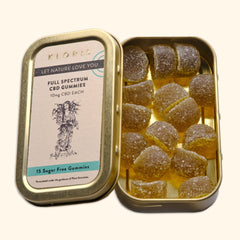
If you’ve been reading our recent articles, you’ll probably be getting pretty familiar with the relationship between cannabinoids, such as CBD and THC, and the endocannabinoid system (ECS).
This complex network spans the entirety of the human body (and is present in many other animals too) and the way cannabinoids bind to and activate its receptors is a large part of the reason why we now know the cannabis plant to be so uniquely beneficial in so many different ways. But it’s not the only reason.
Despite the fact that we talk a lot about the interaction between CBD and the CB1 and CB2 receptors in the ECS, the role it generally plays here is one of an antagonist – meaning it blocks the receptor, rather than activates it. As it does so, the ‘bliss’ molecule anandamide is prevented from activating those receptors and, in conjunction with CBD inhibiting the FAAH enzyme which breaks the bliss molecule down, is therefore allowed to flow freely in higher quantities around the bloodstream.
When the psychoactive cannabinoid THC is present, as in full spectrum products, CBD can also act as an inverse agonist meaning it induces an opposite response. In this case, this modulates much of the ‘stoned’ feeling high levels of THC can cause as it goes about its business.
But while CBD has this indirect action on ECS receptors, there are a number of other receptors in the body for which it is an agonist – activating the receptor directly. Let’s take a look at some of those receptors and how these interactions impact the body:
Serotonin receptors
Serotonin is a very important chemical and neurotransmitter which is known for regulating many bodily processes, including mood, digestion, sleep, bone density and sexual function. However, there are plenty of things which can lead to a serotonin deficit, such as exposure to ongoing stress, poor diet, lack of sleep, lack of sunlight and age-related and hormonal changes which often come hand in hand with the menopause. The results can be symptoms of anxiety, depression, muscle pain, headaches, insomnia and more.
There are various ways to boost serotonin levels but alternatively, CBD can fill in as this molecule has also been shown to directly activate the 5-HT1A (hydroxytryptamine) serotonin receptor. Ordinarily, this family of receptors (present in both the central and peripheral nervous systems) would be activated by serotonin to assist with a variety of biological and neurological processes (including anxiety, sleep, pain perception and nausea), but CBD acts in much the same way.
Although the raw version of the cannabis plant does not contain the cannabinoids known to produce the effects of heated molecules (like CBD and THC), it does contain the precursors to these. Preclinical trials have indicated that CBDA (Cannabidiolic acid – the raw version of CBD) potentially has an even stronger activation effect on these serotonin receptors than CBD. There are still more tests to be done, but this opens up an exciting new area of research in the cannabis industry!
Vanilloid receptors
Another family of receptors CBD directly activates are the Vanilloid receptors (TRPV1), which are also triggered by the active components in vanilla and capsaicin in chilli peppers, as well as anandamide. When activated, these receptors can help mediate pain perception, body temperature, inflammation and metabolism.
Interestingly (and perhaps a little confusingly!) the main role of TRPV1 receptors is to induce pain! A signal from body to brain to inform and protect. However, prolonged activation of these receptors through the use of TRPV1 agonists (such as CBD, vanilla and capsaicin) desensitises them to an extent, meaning less pain signals sent to your brain and as a result, less pain felt.
Recent research has also indicated that increased activation of the TRPV1 receptors may help prevent seizures in epilepsy patients and be an effective treatment for chronic inflammation.
As more evidence becomes available of CBD’s interaction with the body, we’re learning more and more about the potential this amazing plant holds. As a novel food supplement in the UK, it’s important to remember that CBD products are not intended to treat or cure at this time, but it’s well worth keeping up to date with the latest findings – if nothing else it is undeniably fascinating!
For more easy-to-read info on the inner workings of CBD and the cannabis sativa plant as a whole, keep referring back to the KLORIS blog. We’re thrilled to be able to be a part of your CBD journey of discovery.







